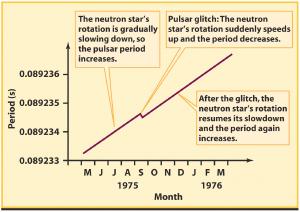Blog
Starquake
3 March 2014
A neutron star is the remnant of a large supernova. When a large star explodes, a remnant of its core is compressed so tightly that the electrons are squeezed into protons, resulting in a mass of neutrons. A neutron star typically has a mass of about 2 solar masses, but it is only about 12 kilometers in diameter. Imagine taking two suns and squeeze it into the size of a small city, and you get the idea of how incredibly dense these objects are. Given their extraordinarily high density and gravity, you might think there is no way a neutron star can be geologically active. But in fact we know that they are active, and even prone to “starquakes”.
We know that starquakes occur by observing a type of neutron star known as a pulsar. Since neutron stars have strong magnetic fields, they generate intense x-ray beams that stream from the magnetic polar regions. If this beam is aligned so that it can point in our direction we see it flash regularly, with a flash for every rotation of the pulsar. You can think of a pulsar as a kind of cosmic lighthouse, if you will. Since the rate at which a pulsar flashes is determined by the rate at which it rotates, if you see a pulsar flash 10 times a second, you know it rotates once every tenth of a second. (It can be a bit more complicated than that, but you get the idea).
 Sushan Konar
Sushan KonarThe rotation of a pulsar is usually pretty regular. Pulsars can gradually slow down over thousands or millions of years due to its radiated energy, but this is a gradual process. Occasionally, however, a pulsar will speed up just a bit in a very short time (on the order of minutes). This rapid speed-up is known as a glitch. After a glitch the pulsar will return to its previous speed within weeks or months, and then continue with its gradual, thousands-year slowdown.
It is generally thought that these glitches are due to changes in the shape of the neutron star. Because of their rotation, neutron stars should bulge a bit at their equator. The faster their rotation, the greater the bulge. As a neutron star gradually slows down, its equatorial bulge would tend to decrease. But it’s thought that the neutron matter in the crust of the star is fairly rigid. This means that as the pulsar gradually slows down, stresses would build up in the pulsar’s crust. This would eventually reach a breaking point. The crust would then collapse to form a more stable, less bulgy shape. Because of this new shape, the pulsar would speed up a bit, just like a spinning figure skater who spins faster when she pulls her arms inward.
Smaller glitches can also occur when the rotation of a pulsar shifts between layers. A neutron star has an outer crust about a kilometer thick, with a superfluid neutron interior. As the neutron star slows down, its crust slows at a higher rate than its core. When the rotations of the crust and interior differ by too much, some of the rotational momentum of the core is transferred to the crust, causing it to speed up slightly. The result is a minor glitch in a pulsar’s period.
Because we can measure a pulsar’s rotation is so precisely, we can actually see the effects of interior and crustal activity. Which is pretty cool when you realize that it is an object light years away and about the size of Deimos, the smaller moon of Mars.